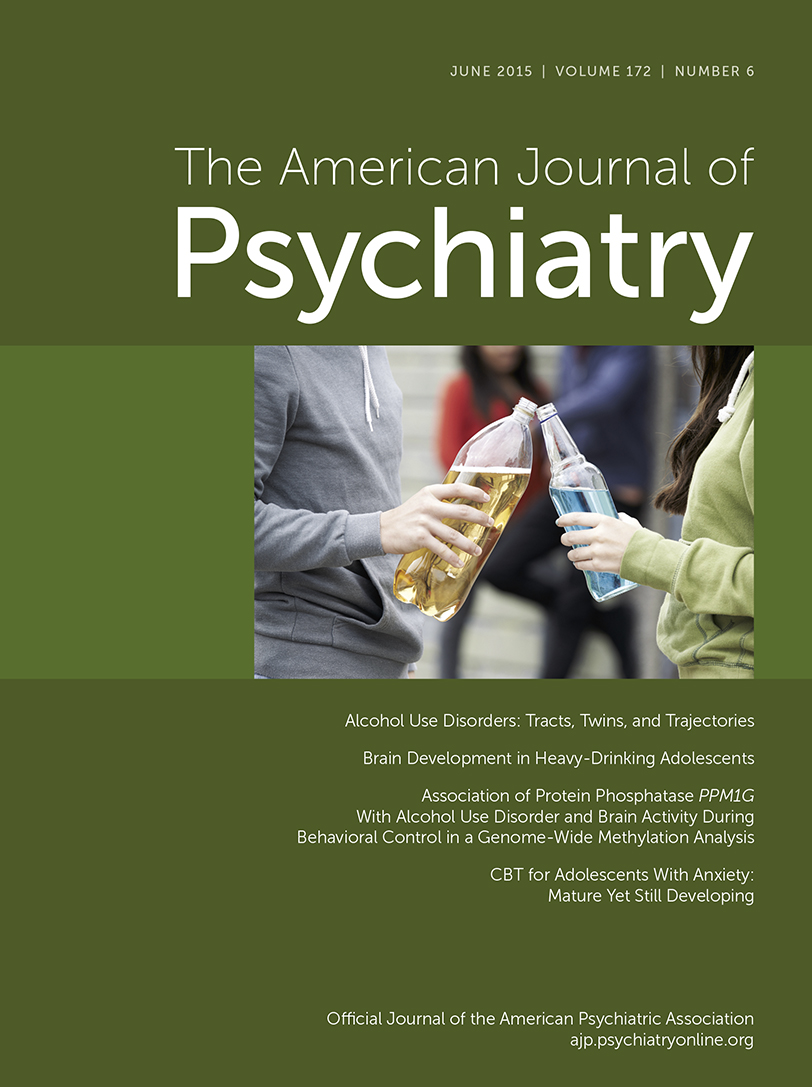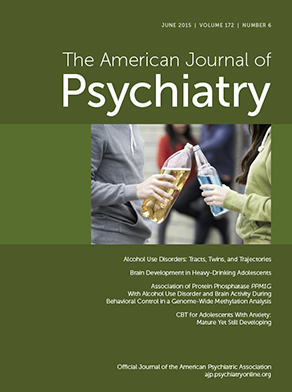In this issue, Rajji et al. (
1) present evidence that the ratio of plasma levels of clozapine to
N-desmethylclozapine (NDMC), clozapine’s active metabolite, is a better predictor of working memory in patients with schizophrenia than either alone—a finding relevant to the controversy about whether any atypical antipsychotic has more than minimal value in treating cognitive impairment associated with schizophrenia (
2–
4). Rajji et al. also found that none of the other six dimensions of schizophrenia-related cognitive impairment was associated with either this ratio or the plasma levels of either compound alone. These findings confirm previous reports that in adult chronic schizophrenia patients, the ratio of the plasma levels of these two agents, but not the levels of either alone, selectively predicts working memory performance (
5,
6). The unique relationship of the ratio of their plasma levels, which is often expressed as the ratio of NDMC to clozapine (
2,
7,
8), has also been reported to better predict improvement in some outcome measures related to psychopathology and function during clozapine treatment in adults with schizophrenia (
5) and overall outcome in children with the disorder (
7).
There are a number of remarkable aspects of this robust finding (
1,
5–
7) that merit attention, including 1) the pharmacologic mechanisms that have been proposed to account for the relationship of the ratio to working memory; 2) the apparent competition between NDMC, the metabolite, which is most responsible for better working memory, and clozapine, the parent compound, which has a negative effect on working memory; 3) the selective relationship between the ratio and working memory, and none of the other dimensions of schizophrenia-related cognitive impairment, with the possible exception of executive function, to which it is closely related (
5); 4) the worsening of working memory during clozapine treatment in most patients during the first 6 weeks and its recovery to baseline levels by 6 months (
9); and 5) the fact that clozapine treatment is effective at 6 weeks, and even more so at 6 months (
9), as are other atypical antipsychotics, in improving performance in other cognitive dimensions—verbal fluency, declarative memory, speed of processing, and attention (
10–
13).
Before discussing these issues, some comments on the report by Rajji et al. are in order. This open clinical trial was a hypothesis-based cross-sectional study, not a prospective trial; its principal aim was to show that a higher NDMC/clozapine ratio predicted better working memory than levels of either compound alone. This was confirmed. No baseline measures of working memory were obtained at initiation of clozapine, and the duration of clozapine treatment when plasma levels were obtained and cognitive testing took place was not specified. However, all patients received clozapine monotherapy for at least 3 months, a major advantage over studies that permit polypharmacy with multiple antipsychotics and other psychotropic drugs. This is highly likely to cause heterogeneity in response. The study did not assess whether
improvement in working memory is associated with a higher ratio, as did the 2004 study by Weiner et al. (
5) from our laboratory. High levels of dopamine D
2 receptor blockade from conventional antipsychotics interfere with the positive effects of atypical antipsychotics in animal models of schizophrenia-related cognitive impairment (
14). Furthermore, tardive dyskinesia, the result of long-term treatment with conventional antipsychotics, has been shown to impair the ability of atypical antipsychotics to improve some but not all domains of cognition in patients with schizophrenia (
15). Duration of treatment in all studies of clozapine is critical because, if it is less than 6 months, some patients may be transitioning from drug-induced impairment to drug-related improvement (
9). In the Weiner et al. study (
5), which reported that NDMC/clozapine ratio predicted improvement in a test of working memory, cognitive testing took place at baseline, at 6 weeks, and at 6 months, permitting inquiry about prediction of change as a function of plasma ratio. This needs to be replicated. The majority of studies of the effect of atypical antipsychotics on schizophrenia-related cognitive impairment are less than 12 weeks in duration and may have underestimated the benefit these agents produce, which may contribute to lower effect sizes and response rates.
To explain the basis for the relationship between working memory and the clozapine/NDMC ratio, but not other dimensions of schizophrenia-related cognitive impairment, Rajji et al. call attention to NDMC as a muscarinic M
1 agonist and clozapine as an M
1 antagonist, leading to opposite influences on working memory. There is strong evidence that M
1 agonism has a positive influence on working memory, more so than on other domains of cognition, while the opposite is true for M
1 antagonism (
16). Rajji et al. present evidence that total serum anticholinergic activity was not associated with working memory, and they suggest that this was due to the ability of NDMC to overcome the anticholinergic load of clozapine. In the absence of NDMC, higher clozapine levels would be expected to impair working memory because of clozapine’s potent anticholinergic properties. The muscarinic receptor-mediated effects of both compounds must be considered in light of the evidence from our laboratory that they both increase the release of acetylcholine in the cortex, hippocampus, and dorsal striatum of rats (
17). Increased levels of acetylcholine will enhance the action of NDMC at muscarinic receptors and oppose, but apparently not eliminate, blockade of muscarinic receptors by clozapine. The acetylcholine increase will also stimulate α7 and α
4β2 nicotinic receptors, which would be expected to have a procognitive effect (
18), at least in some patients, on some dimensions of cognition, contributing to the variability in response among drugs, domains, and patients, leading to small effect sizes and obscuring individual improvement (
4).
Both clozapine and NDMC also enhance the release of dopamine in the prefrontal cortex, hippocampus, and dorsal striatum (
17), leading to stimulation of dopamine D
1 and D
4 receptors. Stimulation of D
1 receptors would be expected to have a powerful positive effect on cognition, and D
4 agonism might also. D
4 antagonism has the opposite effect. NDMC is a much weaker D
4 antagonist than clozapine (
4,
8), which may, along with M
1 antagonism, contribute to the greater ability of NDMC to enhance working memory. There is extensive evidence that COMT genetic variation affects working memory in schizophrenia (
19), indicating that within-subject variability, for genetic and other reasons, may have a powerful overriding influence on the net effect of treatment with clozapine and its partial conversion to NDMC. There is much evidence that excessive stimulation of D
1 and (
20) α
7 nicotinic (
21) receptors leads to diminished functional effect, generally referred to as an inverted-U shaped dose-response curve. There is some evidence for this same type of dose-response curve for α
4β2 nicotinic, muscarinic M
1, and D
4 receptors. The combined direct and indirect effects of clozapine and NDMC on these receptors, whether optimal, under-, or overstimulation, will affect their effects on working memory.
Both NDMC and clozapine are potent serotonin (5-HT)
2A, 5-HT
2C, 5-HT
6, 5-HT
7 receptor antagonists, and partial agonists at 5-HT
1A receptors (
5,
8). All of these are procognitive. However, there is evidence (beyond the scope of this review) that clozapine is a more potent antagonist at GABA
A receptors and a more potent 5-HT
1A partial agonist, which would make clozapine more effective than NDMC in improving cognition, but not working memory, in patients with schizophrenia. In summary, the pharmacology of NDMC and clozapine is exceedingly rich with regard to possible mechanisms for affecting cognition through multiple direct and indirect dopaminergic and cholinergic mechanisms. Other atypical antipsychotics also share these indirect mechanisms and some of the procognitive and cognition-impairing mechanisms. On the other hand, the conventional antipsychotics, because of their potent D
2 receptor blockade, which is anticognitive overall (
22), and the use of anticholinergic drugs to offset extrapyramidal symptoms, would be expected to show—as they in fact do—lesser ability than atypical antipsychotics to improve schizophrenia-related cognitive impairment (
10–
13). Taken together, the NDMC/clozapine clinical data (
1,
5–
7) provide strong evidence for a pharmacologic approach to treating schizophrenia-related cognitive impairment, using specific muscarinic or nicotinic receptor agonists or positive allosteric modulators, alone or in combination, with atypical antipsychotics (
4,
18).
These comments on the Rajji et al. study and issues such as tardive dyskinesia and polypharmacy help us understand the conclusion drawn by some that the atypical antipsychotics are without any significant benefit in schizophrenia-related cognitive impairment (
2,
3), even though all meta-analyses of the studies of atypical antipsychotics in schizophrenia have shown small to moderate positive effect sizes for specific domains of cognition and sometimes for composite scores (
10–
13). The mean effect sizes are unimpressive to some because many patients will not respond, for the reasons mentioned above. Yet, as Willy Loman’s wife Linda insists in Arthur Miller’s
Death of a Salesman, attention must be paid to what has been accomplished, not only the to gap between aspiration and achievement. For the topic at hand, this means acknowledging the importance of the fact that a sizable minority of schizophrenia patients do improve in some domains of cognition when treated with atypical antipsychotics, to an effect beyond practice effect level, and placing priority on understanding the basis for the diversity in improvement, as illustrated by the consistent data relating the NDMC/clozapine ratio to better working memory in some patients with schizophrenia (
1,
5–
7).

